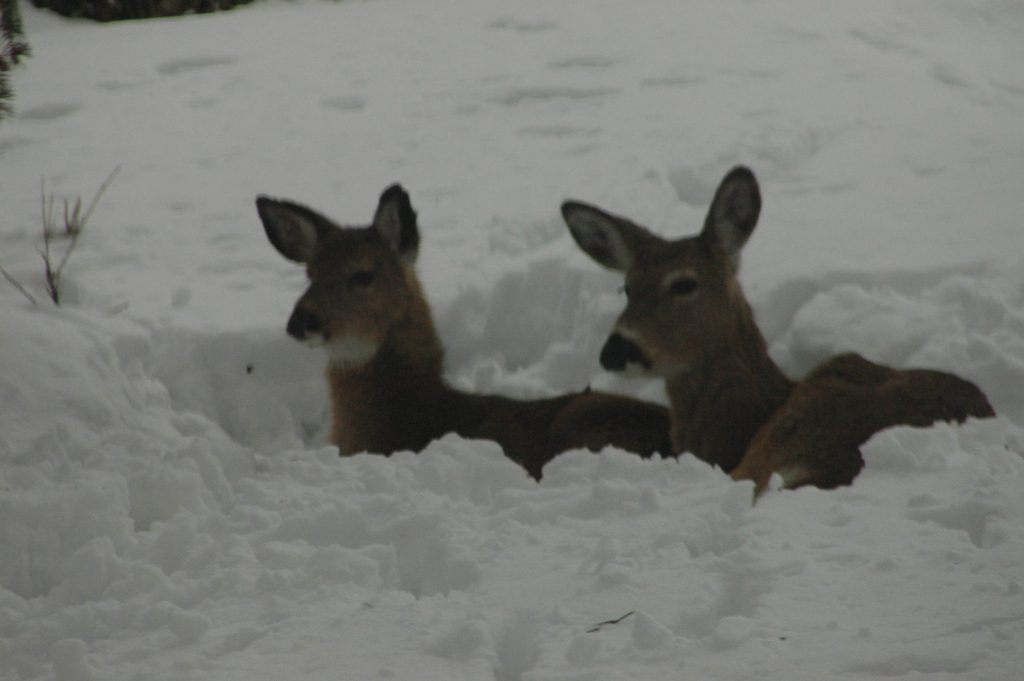I spent 2 winters in Minnesota.
There I learned you NEVER leave the house in winter (which lasted 8 months of the year!) without your hat, mittens, scarf, fleece windproof vest, long johns, insulated boots, and L.L. Bean coat rated for -40 degrees.
Deer live in Minnesota. They also live in southern Canada where temperatures are lower and snow is deeper for longer. In all my years working with white-tailed deer, I have never seen one sporting insulated boots or an L.L. Bean coat.
How can this be? Deer withstand temperatures that would freeze us like popsicles.
While L.L. Bean makes some awesome gear, they have yet to design anything like that donned by the white-tailed deer.

Behold the marvel of evolution. A warm-blooded, heat-producing entity laying in the snow WITHOUT melting it.
Coarse, hollow, dark guard hairs cover soft, woolly underfur. Guard hairs can absorb solar energy and help reduce energy expenditure. But their primary function is to protect the underfur.
Long and waterproof, guard hairs channel moisture away from the underfur and skin. It is a misconception that these hollow guard hairs are unique to deer and provide the bulk of insulation. Many other species have hollow guard hair including other members of the deer family (elk, moose, caribou), polar bears, wolves, and even llamas.

It’s the underfur that makes deer feel like they are wrapped in a fuzzy blanket by a crackling fire. Half the length of guard hairs, underfur is 5 times as dense. For comparison, sheep underfur is only 4 times as dense. The underfur traps layers of air, with warmer layers closer to the skin. The insulative value of underfur is increased when the hair stands on end (goose bumps for people) trapping more air. Sebaceous glands in the skin produce a water-repellent oil that coats hair filaments as well.
The tail and the belly exhibit the highest density of hair, the highest concentration of sebaceous glands, and the thinnest epidermis while the legs have lowest hair density, the highest amount of sudoriferous glands, and the thickest epidermis.
This makes sense as the best insulation needs to be on the side that comes in contact with the ground as well as the circumanal area (a deer’s fanny) which is relatively exposed. Extra water-proofing (sebaceous glands) and more hair fit the bill. Guard hair density on the tail is 4.46 per square-millimeter.
Sudoriferous glands are sweat gland in cervids. As with everything, there is a trade off. While warmth is important so is cooling. Less hair on legs and high concentration of sudoriferous glands allow for evaporative cooling when needed.
There was a report of a doe in Pennsylvania that had no guard hairs, just her silky soft underfur. While underfur is super insulation, it is not weather-proof. She would likely not have survived as wet underfur would become matted and frozen completely losing its ability to act as insulation. To ride out the winter, a deer needs both.
So while deer do not enjoy the 100% satisfaction guarantee that L.L. Bean provides, I’m pretty sure they don’t need it.
-Jeannine Fleegle, biologist
PGC Deer and Elk Section
Photo credits: Deer snow angel, Brian Clark; Deer bedded in snow, Jeannine Fleegle
If you would like to receive email alerts of new blog posts, subscribe here.
And Follow us on Twitter @WTDresearch

